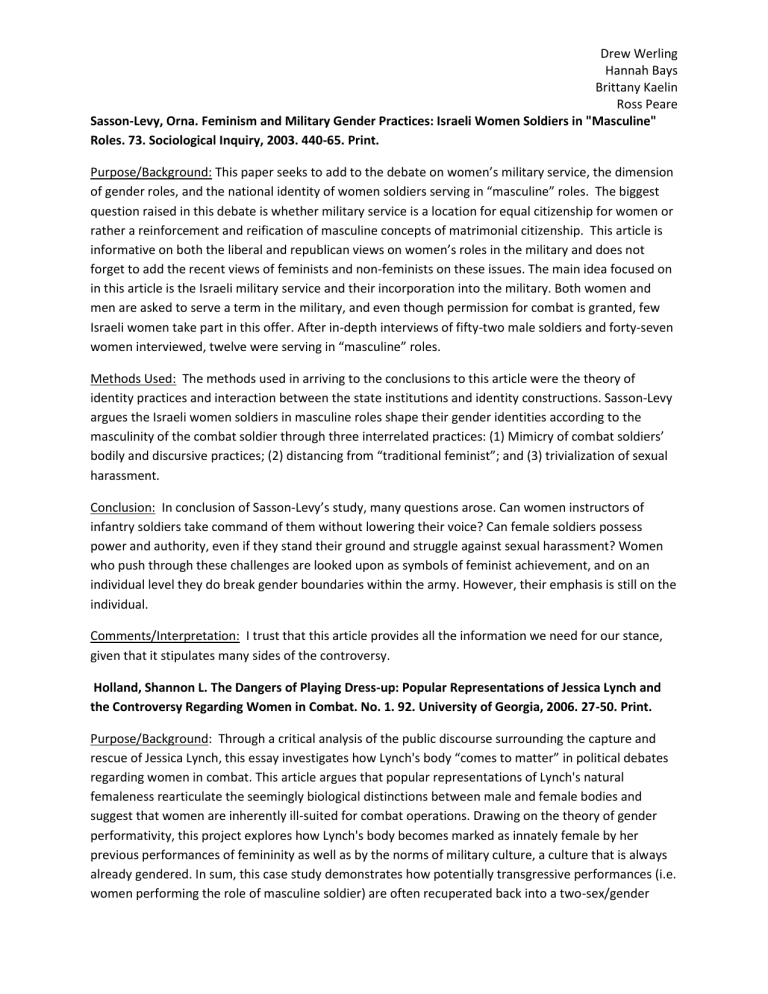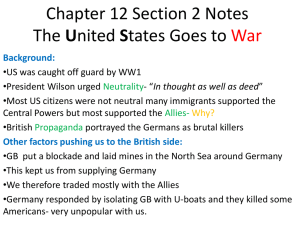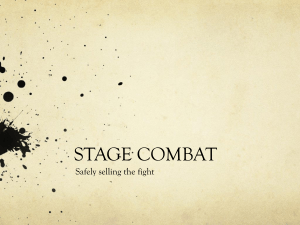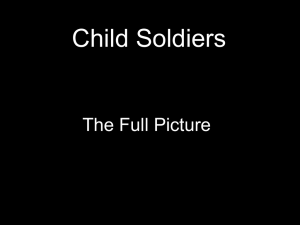Annotated Bibliography

Drew Werling
Hannah Bays
Brittany Kaelin
Ross Peare
Sasson-Levy, Orna. Feminism and Military Gender Practices: Israeli Women Soldiers in "Masculine"
Roles. 73. Sociological Inquiry, 2003. 440-65. Print.
Purpose/Background: This paper seeks to add to the debate on women’s military service, the dimension of gender roles, and the national identity of women soldiers serving in “masculine” roles. The biggest question raised in this debate is whether military service is a location for equal citizenship for women or rather a reinforcement and reification of masculine concepts of matrimonial citizenship. This article is informative on both the liberal and republican views on women’s roles in the military and does not forget to add the recent views of feminists and non-feminists on these issues. The main idea focused on in this article is the Israeli military service and their incorporation into the military. Both women and men are asked to serve a term in the military, and even though permission for combat is granted, few
Israeli women take part in this offer. After in-depth interviews of fifty-two male soldiers and forty-seven women interviewed, twelve were serving in “masculine” roles.
Methods Used: The methods used in arriving to the conclusions to this article were the theory of identity practices and interaction between the state institutions and identity constructions. Sasson-Levy argues the Israeli women soldiers in masculine roles shape their gender identities according to the masculinity of the combat soldier through three interrelated practices: (1) Mimicry of combat soldiers’ bodily and discursive practices; (2) distancing from “traditional feminist”; and (3) trivialization of sexual harassment.
Conclusion: In conclusion of Sasson-Levy’s study, many questions arose. Can women instructors of infantry soldiers take command of them without lowering their voice? Can female soldiers possess power and authority, even if they stand their ground and struggle against sexual harassment? Women who push through these challenges are looked upon as symbols of feminist achievement, and on an individual level they do break gender boundaries within the army. However, their emphasis is still on the individual.
Comments/Interpretation: I trust that this article provides all the information we need for our stance, given that it stipulates many sides of the controversy.
Holland, Shannon L. The Dangers of Playing Dress-up: Popular Representations of Jessica Lynch and the Controversy Regarding Women in Combat. No. 1. 92. University of Georgia, 2006. 27-50. Print.
Purpose/Background: Through a critical analysis of the public discourse surrounding the capture and rescue of Jessica Lynch, this essay investigates how Lynch's body “comes to matter” in political debates regarding women in combat. This article argues that popular representations of Lynch's natural femaleness rearticulate the seemingly biological distinctions between male and female bodies and suggest that women are inherently ill-suited for combat operations. Drawing on the theory of gender performativity, this project explores how Lynch's body becomes marked as innately female by her previous performances of femininity as well as by the norms of military culture, a culture that is always already gendered. In sum, this case study demonstrates how potentially transgressive performances (i.e. women performing the role of masculine soldier) are often recuperated back into a two-sex/gender
Drew Werling
Hannah Bays
Brittany Kaelin
Ross Peare schema for the purpose of “making sense” of those performances and of institutions that are founded upon the disciplining of gendered bodies.
Methods Used/Summary: Methods used for this article were the personal experiences of Jessica Lynch and her adventure. The representations of Lynch's capture and rescue narrative, not only attempt to
“set the record straight” by documenting the intimate details of Lynch's experience in Iraq but also attempt to provide an explanation for Lynch's tragic capture by decoding the messages written on her body., thereby creating a sharp contrast between “real” Masculine warriors and their feminine impersonators. Also depicted in this story are the suggestions that Lynch’s presence on the battlefield created a double liability for her unit and also signified women’s overall dependency on men, the protectors.
Comments/Interpretation: Overall, we enjoyed this article as it portrayed a very person account of not only the struggles of Lynch but how she overcame these struggles and shot down the negative views surrounding women in the military.
Durning, Kathleen P. "Women in the Military." Armed Forces and Society 4th ser. Vol.4 (1978): 727-31.
Sage. Web. 10 Nov. 13. <http://afs.sagepub.com.ezproxy.lib.purdue.edu/content/4/4/727>.
Purpose/Background: The authors stated purpose is to provide the basis and rationale for possible change, to present all sides of the issues, and to make recommendations toward optimum utilization, proposing practical measures for immediate action and suggested areas for further research.
Methods Used: The case is made for women’s right to the employment opportunities, job training, pay, and benefits of the military establishment, the nation’s largest employer. Binkin and Bach speculate that there is conflict of interests between equal opportunity.
Summary: There are deep-seated cultural attitudes towards women in combat, and these would have to be changed in order for women to serve in combat. They also suggest that since there is a 25% decrease in recruitment that by opening up more positions to women you could increase this percentage. It later goes on to talk about the different positions in the military that could be filled by women, and how the military would benefit from this.
Conclusion: In conclusion they believe that a lot of this change has to happen in Congress to allow women to be able to have these types of job opportunities, and lots of issues would have to be addressed. We think that this article has a lot of strengths. It has a lot of good facts in it. It also has rational thinking into how our society envisions what women should be doing. The article does a good job at explaining the ways that having women in the military would help it.
Drew Werling
Hannah Bays
Brittany Kaelin
Ross Peare
Hurrell, Rose Marie. "Attitudes toward Women in the Military during the Persian Gulf War."
Perceptual and Motor Skills 78 (1994): 99.
Http://www.amsciepub.com.ezproxy.lib.purdue.edu/doi/abs/10.2466/pms.1994.78.1.99. Ammons
Scientific. Web. 10 Oct. 2013.
Purpose/Background: This study describes the development of a scale to measure public attitudes toward women in the military and reports its use with a sample of 97 college women surveyed during the Persian Gulf war.
Methods Used: Analysis indicates that the scale has acceptable internal consistency, reliability, and is relatively free of social desirability as measured by the Marlowe-Crowne Social Desirability Scale. A significant positive correlation between scores on the scale and on the Sex-role Ideology Scale suggests support for the validity of the new scale.
Summary: With regard to the attitudes assessed, the results indicate that subjects tend to favor attitudes endorsing the equivalent capacities of men and women to function in the military. When issues of combat or women's roles as wives and mothers are considered, scores tend to reflect less support for women in the military.
Interpretation/Comments: We thought that this article’s weakness was the amount of people used in the survey. We thought that there should’ve been more women involved in this study, however the results were interesting, and you could capture the general consensus. The relevance of this to our project is that it gives us an idea of people’s opinions when it comes to women in the military.
Goldman, Nancy. "The Utilization of Women in the Military." Annals of the American Academy of
Political 406 (1973): 107-16. Print.
Purpose/Background: This study talked about how in the decade of the 1970s there will be an increase in the number and percentage of women in the United States military.
Methods Used: Trends indicate that this rise will move steadily but gradually from less than 2 percent women in the armed services to approximately 4 percent. Although the number and percent of women in uniform will remain small, their increase will assist in meeting the expected "short fall" in manpower.
The trend to expand the number of women in the military will continue in the 1980s, but it seems unlikely that a 10-percent level, which could be considered possible, will be reached. Historically in industrialized countries women have been excluded from armed combat roles and significant positions in administration. They have served as nurses, secretaries, and clerks and in routine types of communications. Each service has made plans and proposals to increase the number of women and the variety of jobs open to them and to deal with other expressed dissatisfactions, such as living quarters and regulations related to the retention of the careers of married women.
Drew Werling
Hannah Bays
Brittany Kaelin
Ross Peare
Conclusion/Summary: Additional problems of protocol between the sexes and the integration of women in the military will have to be faced. Although it is likely that the military will continue its tradition of excluding women from direct combat positions, with an increased emphasis on deterrence there will be an increase in the number of positions in which the "fighting spirit" is irrelevant, many of which will become available to women.
Interpretation/Comments: Overall we thought that this article was interesting, and we agreed with her argument that there are many issues that will have to be faced with the integration of women into the military. We also agreed that there needs to be more jobs that are open to women.
Segal, Mady. “Women's Military Roles Cross-Nationally: Past, Present, and Future” Gender and
Society , Vol. 9, No. 6 (Dec., 1995), pp. 757-775. Print.
Purpose/Background: Expanding on an overall view of women in the military, this article provides a historical overview of women’s roles in the military as wells as some present (1995) insight of gender issues in the military. Likely causes of different levels of participation and acceptance of women’s participation in the military are discussed. Additionally, there are a number of different countries examined with their history to discover some of the factors that increase acceptance of women in the military. This brings in the role of culture and its effect on these rates.
Methods Used: This article utilized analyses from different countries as well as historical documents to investigate three variables that affect women’s rights to participate in the military. These are (1) the military itself, (2) social structure, and (3) culture. The article lists these three factors as the greatest determiners in women’s participation in the military, then goes on to justify each one.
Results: The article uses historical evidence to justify the position of the article that the three aforementioned factors are important to women’s participation in the military and women’s rights in general.
Conclusion: The article concluded that, indeed, these three factors are imperative to women in the military.
Interpretation/Comments: We chose this article to provide some historical context to our movement. A historical framework will help us to demonstrate the importance of the role women play in the military, as well as the
Kirk, Gwyn, and Margo Okazawa-Rey. "Women Opposing U.S. Militarism In East Asia." Peace Review
16.1 (2004): 59-64. Academic Search Premier. Web. 24 Oct. 2013.
Purpose/Background: Differentiated from some of our other articles, this examines some of the effects of militarism and the military on civilian women. It focuses on instances in East Asia and rape by U.S. military member.
Methods: This article uses specific case studies to demonstrate the nature of the U.S. military.
Additionally, there is data regarding abuse by U.S. soldiers of civilians.
Drew Werling
Hannah Bays
Brittany Kaelin
Ross Peare
Results: The article finds U.S. militarism as a major problem that leads to abuse of local civilians. Sexual assault is found as a result of the militant U.S. forces.
Conclusion: The article sees demilitarization as a solution to the militant status of the U.S. military.
Additionally, a change in the culture of the U.S. military can help reduce the cases of violence against women, both in the military, and of civilians.
Interpretation/Comments: We saw this article as a way to relate issues facing women in the military to those facing civilians and ourselves as a part of the
Turchik, Jessica, and Susan Wilson. "Sexual assault in the U.S. military: A review of the literature and recommendations for the future." Aggression and Violent Behavior. 15.4 (2010): pp. 267-77. Print.
Purpose/Background: This article addresses the recent increase in sexual assault in the military.
Additionally, it continues to expand upon the issues regarding the presence of women in the military.
Causes of such high rates of sexual assaults are discussed in the article. These include the culture of the military and hypermasculinity.
Methods Used: The article uses current data to explain some of the trends involved in violence and sexual assault in the military. Additionally, data is collected that is relevant to militarism and the hypermasculinity involved in the military culture.
Results: Among other topics, low report rates of sexual assault in the military are seen as a result of military culture and the “don’t talk about it” nature.
Conclusion: Finally, there are possible solutions discussed. These include stricter legal repercussions for sexual assault in the military, changing the masculine nature of the military, and more stringent recruiting procedures for the military that limit the entrance of those with violent and criminal histories.
Interpretation/Comments: We chose this article because it expands on the issues that women face when joining the military, as well as the continued consequences of militarism and abuse toward women.







